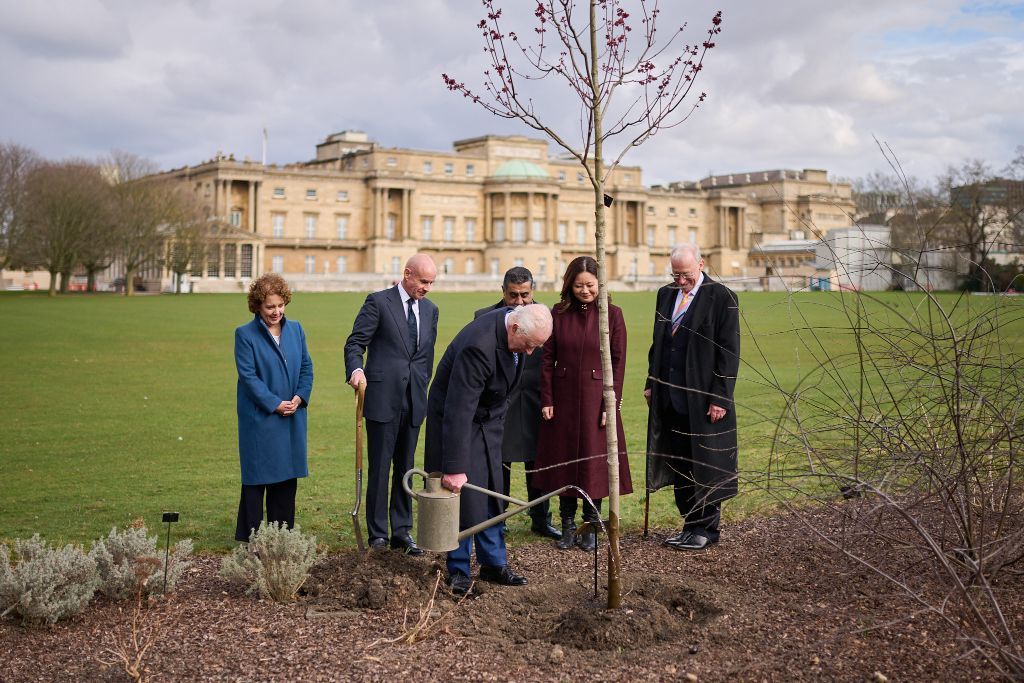King Charles Plants Commemorative Tree at Buckingham Palace to Mark Commonwealth Conservation Success
King Charles III has planted an Acer rubrum 'October Glory' maple tree in the grounds of Buckingham Palace to commemorate the achievements of The Queen's Commonwealth Canopy, a groundbreaking environmental initiative launched in his late mother's name.

King Charles III has planted an Acer rubrum 'October Glory' maple tree in the grounds of Buckingham Palace to commemorate the achievements of The Queen's Commonwealth Canopy, a groundbreaking environmental initiative launched in his late mother's name.
The tree-planting ceremony, which took place yesterday, celebrates the successful completion of the project while recognising the King's longstanding commitment to environmental conservation and the enduring bond between Commonwealth nations.
The ceremonial maple, personally selected by His Majesty, was planted at the lake edge in Buckingham Palace gardens. It is the third Acer rubrum 'October Glory' to grace the royal grounds.
Launched at the 2015 Commonwealth Heads of Government Meeting in Malta, The Queen's Commonwealth Canopy was the first environmental initiative named after Queen Elizabeth II. The project concluded in 2022 after achieving pan-Commonwealth participation.
Originally envisioned as a network of forest conservation initiatives spanning the Commonwealth, the project's remarkable legacy includes the protection of approximately 115 sites across the Commonwealth, conserving more than 12 million hectares of indigenous forests and botanical gardens.
Dr Linda Yueh CBE, Executive Chair of the Royal Commonwealth Society, which served as managing partner for the initiative, described the project as "a remarkable example of the Commonwealth's united effort to create a sustainable future for its 2.7 billion citizens."
"It brought together governments and organisations to conserve diverse forests, including UNESCO World Heritage sites and those Queen Elizabeth II personally visited during her 70 years of service," Dr Yueh said.
"We are deeply honoured that His Majesty The King, Patron of the Royal Commonwealth Society, commemorated this achievement by planting an Acer rubrum, creating a lasting symbol of the Commonwealth's commitment to environmental conservation and The late Queen's legacy."
The Royal Commonwealth Society worked alongside the Commonwealth Forestry Association and Cool Earth to implement the ambitious project.
Alan Pottinger, Executive Director of the Commonwealth Forestry Association, said it had been "an honour" to play a role in raising awareness amongst Commonwealth citizens about the value of trees and forests.
"It is a fitting tribute to Queen Elizabeth II that her son and stalwart champion of the environment, King Charles III, should help to commemorate the successful completion of the project," Mr Pottinger added.
Tony Juniper CBE, Chair of Cool Earth, reflected on the vision of Frank Field, who originally proposed the initiative, saying he "would have been delighted to see his vision come to fruition as proof of the Commonwealth's commitment to the natural world and its fight against the climate crisis."
The tree-planting ceremony comes as part of King Charles's continued focus on environmental issues, a cause he has championed for decades. As Prince of Wales, he was a vocal advocate for sustainability and conservation efforts, and has maintained this focus since ascending the throne.
Environmental experts have praised the success of The Queen's Commonwealth Canopy as an example of how international cooperation can achieve significant conservation outcomes, particularly in preserving vital indigenous forests for future generations.
The Acer rubrum 'October Glory', known for its spectacular autumn display of brilliant red foliage, will serve as a living reminder of both Queen Elizabeth II's legacy and the Commonwealth's ongoing commitment to environmental protection.





